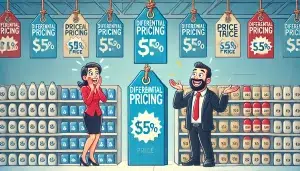
Table of Contents
- Introduction
- What is Price Elasticity
- Types of Price Elasticity
- Calculating Price Elasticity
- Factors Affecting Price Elasticity
- Real-World Examples
- Price Elasticity and Business Strategy
- Common Misconceptions
- My Experience with Price Elasticity
- How Pricefy Can Help
- Conclusion
- FAQs
- Useful Links
Introduction
Price elasticity is a measure of how sensitive demand or supply is to changes in price. It’s like a financial rubber band, stretching or contracting as prices fluctuate. In essence, price elasticity tells us how much the quantity demanded or supplied of a good or service changes when its price changes. This concept is crucial for businesses, economists, and policymakers to understand market dynamics and make informed decisions.
What Exactly is Price Elasticity?
Price elasticity is the percentage change in quantity demanded or supplied divided by the percentage change in price. It’s a way to quantify how much people or producers react to price changes. If a small price change leads to a big change in quantity, that’s elastic. If a big price change barely budges quantity, that’s inelastic.
Why Does It Matter?
Understanding price elasticity is like having a crystal ball for your business. It helps you predict how customers will react to price changes, which is pure gold for pricing strategies. Plus, it’s a key player in maximizing revenue and profits. Neglecting price elasticity is like sailing without a compass – you might move, but you’re not sure where you’re headed!
Types of Price Elasticity
There are several types of price elasticity, each offering unique insights into market behavior:
- Price Elasticity of Demand (PED): Measures how quantity demanded responds to price changes.
- Price Elasticity of Supply (PES): Shows how quantity supplied reacts to price changes.
- Cross-Price Elasticity: Reveals how demand for one product changes when the price of another product changes.
- Income Elasticity: Indicates how demand changes as consumer income changes.
Key Points:
- Elastic demand: Small price changes lead to large changes in quantity demanded.
- Inelastic demand: Large price changes result in small changes in quantity demanded.
- Unit elastic: Percentage change in quantity equals the percentage change in price.
Calculating Price Elasticity

Ready to crunch some numbers? Here’s how to calculate price elasticity of demand:
- Gather data on price and quantity before and after a change.
- Calculate percentage change in quantity: (New Quantity – Original Quantity) / Original Quantity * 100
- Calculate percentage change in price: (New Price – Original Price) / Original Price * 100
- Divide percentage change in quantity by percentage change in price.
The formula looks like this:
Price Elasticity of Demand = (% Change in Quantity Demanded) / (% Change in Price)Pro tip: The absolute value of this number is what really matters. Negative signs just indicate the inverse relationship between price and quanity demanded.
Factors Affecting Price Elasticity

Several factors can make a product more elastic or inelastic:
- Availability of substitutes
- Necessity vs. luxury
- Proportion of income spent
- Time frame
- Brand loyalty
For example, insulin is pretty inelastic because it’s a necesity with few substitutes. On the flip side, designer handbags are elastic because they’re luxury items with many alternatives.
Real-World Examples
Let’s bring this concept down to earth with some real-world examples:
- Gasoline: Despite price fluctuations, people still need to drive. This makes gasoline relatively inelastic in the short term.
- Movie tickets: With alternatives like streaming services, demand for movie tickets is more elastic.
- Cigarettes: Despite price increases, many smokers continue to buy cigarettes, making them relatively inelastic.
According to a study by the American Economic Review, the price elasticity of demand for gasoline in the US is about -0.37, meaning a 10% increase in price leads to only a 3.7% decrease in quantity demanded.
Price Elasticity and Business Strategy
Understanding price elasticity is like having a secret weapon in your business arsenal. It helps you:
- Set optimal prices
- Predict sales volume
- Understand consumer behavior
- Make informed decisions about production
For instance, if you know your product has inelastic demand, you might consider raising prices to increase revenue. On the other hand, for products with elastic demand, you might focus on cost reduction to offer competitive prices.
Common Misconceptions
Let’s bust some myths about price elasticity:
- Myth: Luxury goods are always elastic.
Reality: Some luxury goods, like certain high-end watches, can be inelastic due to brand loyalty and exclusivity. - Myth: Necessities are always inelastic.
Reality: Even necessities can become elastic if prices rise too high or if alternitives become available. - Myth: Price elasticity is constant.
Reality: It can change over time due to factors like changing consumer preferences or new technologies.
My Experience with Price Elasticity
In my years of working with businesses, I’ve seen price elasticity work its magic (and sometimes havoc) in various industries. I once consulted for a software company that was considering a price hike. By analyzing their price elasticity, we discovered that a 15% increase would only result in a 5% decrease in sales, ultimately boosting their revenue. It was like finding money they didn’t know they had!
On the flip side, I’ve witnessed companies ignore price elasticity and pay the price (pun intended). A local coffee shop once raised their prices by 25%, assuming their loyal customers wouldn’t mind. They didn’t account for the elasticity of their demand, and sales plummeted. It was a tough lesson in the importance of understanding your market’s sensitivity to price changes.
How Pricefy Can Help
When it comes to navigating the complex world of price elasticity, Pricefy is your trusty co-pilot. This powerful pricing software takes the guesswork out of elasticity calculations and helps you make data-driven pricing decisions.
With Pricefy, you can:
- Analyze historical sales data to calculate price elasticity
- Simulate different pricing scenarios and their impact on demand
- Optimize your pricing strategy based on elasticity insights
- Monitor changes in elasticity over time
Whether you’re a small business owner or a pricing analyst at a large corporation, Pricefy equips you with the tools to harness the power of price elasticity and drive your business forward.
Conclusion
Price elasticity is more than just an economic concept – it’s a powerful tool for understanding markets and making smart business decisions. By grasping the basics of elasticity, you can predict consumer behavior, optimize pricing strategies, and ultimately boost your bottom line.
Remember, elasticity isn’t one-size-fits-all. It varies by product, market, and time frame. So keep your finger on the pulse of your market’s elasticity, and you’ll be well-equipped to navigate the ever-changing seas of supply and demand.
Now that you’re armed with this knowledge, go forth and elasticize your business strategy!
FAQs
Introduction to Price Elasticity
- What is price elasticity in economics?
Price elasticity in economics measures how sensitive the quantity demanded or supplied of a good or service is to changes in its price. It’s a fundamental concept for understanding market dynamics. - What is price elasticity of demand?
Price elasticity of demand (PED) measures how responsive the quantity demanded of a good is to a change in its price, holding all other determinants of demand constant. - What does price elasticity of demand measure?
Price elasticity of demand measures the percentage change in quantity demanded relative to a percentage change in price. It quantifies consumers’ sensitivity to price changes. - What is price elasticity of supply?
Price elasticity of supply (PES) measures how responsive the quantity supplied of a good is to a change in its price, holding all other determinants of supply constant. - What does price elasticity of supply measure?
Price elasticity of supply measures the percentage change in quantity supplied relative to a percentage change in price. It quantifies producers’ ability to adjust output in response to price changes.
Understanding the Concepts
- What is price elasticity of demand and supply?
Price elasticity of demand and supply are related concepts that measure how quantity demanded and supplied, respectively, respond to changes in price. They help understand both consumer and producer behavior in markets. - What is price elasticity of demand in simple words?
In simple words, price elasticity of demand is how much consumers’ buying behavior changes when the price of a product changes. It’s like measuring how “stretchy” consumer demand is. - What is own price elasticity?
Own price elasticity refers to the elasticity of demand for a good with respect to its own price. It measures how the demand for a product changes when its price changes, holding other factors constant. - How does price elasticity affect pricing decisions?
Price elasticity affects pricing decisions by helping businesses understand how changes in price will impact demand and revenue. For elastic goods, lowering prices may increase total revenue, while for inelastic goods, raising prices might be more profitable. - What does a price elasticity of 1 mean?
A price elasticity of 1, also known as unit elasticity, means that the percentage change in quantity demanded is equal to the percentage change in price. For example, a 10% price increase leads to a 10% decrease in quantity demanded.
Formulas and Calculations
- What is the formula for price elasticity of demand?
The formula for price elasticity of demand is:
PED = (Percentage change in quantity demanded) / (Percentage change in price) - How is price elasticity of demand calculated?
Price elasticity of demand is calculated by dividing the percentage change in quantity demanded by the percentage change in price. The steps are:- Calculate percentage change in quantity demanded
- Calculate percentage change in price
- Divide the first result by the second
- How is price elasticity of demand measured?
Price elasticity of demand is measured by observing changes in quantity demanded in response to price changes, either through historical data analysis or controlled experiments. - How is cross-price elasticity of demand calculated?
Cross-price elasticity of demand is calculated similarly to own-price elasticity, but it measures the percentage change in quantity demanded of one good in response to a percentage change in the price of another good. - How do you calculate price elasticity of demand?
To calculate price elasticity of demand:- Gather data on prices and quantities before and after a price change
- Calculate percentage changes in both price and quantity
- Divide the percentage change in quantity by the percentage change in price
- How is price elasticity of demand defined?
Price elasticity of demand is defined as the ratio of the percentage change in quantity demanded to the percentage change in price, always expressed as an absolute value.
Factors Influencing Price Elasticity
- What determines price elasticity of demand?
Price elasticity of demand is determined by factors such as availability of substitutes, necessity vs. luxury status, proportion of income spent, time frame, and brand loyalty. - What factors influence price elasticity of demand?
Factors influencing price elasticity of demand include:- Availability of substitutes
- Necessity vs. luxury status of the good
- Proportion of income spent on the good
- Time frame considered
- Brand loyalty
- Habit-forming nature of the product
- What factors affect price elasticity of supply?
Factors affecting price elasticity of supply include:- Time frame (short-run vs. long-run)
- Availability of resources
- Production capacity
- Storage capability
- Perishability of the product
- Which product has inelastic demand?
Products with inelastic demand typically include necessities or goods with few substitutes, such as:- Prescription medications
- Gasoline (in the short term)
- Basic food items
- Utilities (electricity, water)
- Which statement about price elasticity of demand is most accurate?
The most accurate statement about price elasticity of demand is that it measures the responsiveness of quantity demanded to changes in price, holding other factors constant. - What affects price elasticity of supply?
Price elasticity of supply is affected by factors such as:- Production capacity
- Availability of resources
- Time frame for production adjustments
- Storage capabilities
- Flexibility of production processes
Applications and Real-World Examples
- What is price elasticity of demand in business?
In business, price elasticity of demand is a crucial concept for pricing strategies, revenue management, and understanding consumer behavior. It helps businesses predict how changes in price will affect sales and revenue. - What is price elasticity of demand with examples?
Price elasticity of demand varies across products. For example:- Elastic: Luxury goods (e.g., high-end electronics)
- Inelastic: Necessities (e.g., insulin for diabetics)
- Unit elastic: Some grocery items
- How does price elasticity of demand help in decision making?
Price elasticity of demand helps in decision making by:- Guiding pricing strategies
- Predicting revenue changes from price adjustments
- Informing production planning
- Assisting in market segmentation
- What happens if price elasticity of demand is negative?
A negative price elasticity of demand is normal and expected. It indicates that as price increases, quantity demanded decreases, following the law of demand. - Why is price elasticity of demand important?
Price elasticity of demand is important because it helps businesses and policymakers understand consumer behavior, optimize pricing, forecast sales, and make informed decisions about production and marketing. - Why measure price elasticity of demand?
Measuring price elasticity of demand allows businesses to:- Set optimal prices
- Predict sales volume
- Maximize revenue
- Understand market dynamics
- Develop effective marketing strategies
- When is price elasticity of demand less than 1?
Price elasticity of demand is less than 1 (inelastic) when the percentage change in quantity demanded is less than the percentage change in price. This often occurs with necessity goods or products with few substitutes. - When is price elasticity of demand equal to 1?
Price elasticity of demand is equal to 1 (unit elastic) when the percentage change in quantity demanded is exactly equal to the percentage change in price. - When is price elasticity of demand negative?
Price elasticity of demand is typically negative due to the inverse relationship between price and quantity demanded. A positive value would violate the law of demand in most cases. - When is price elasticity of demand zero?
Price elasticity of demand is zero (perfectly inelastic) when quantity demanded doesn’t change at all regardless of price changes. This is rare but might occur for absolute necessities with no substitutes.
Advanced Topics
- Why is price elasticity of demand negative?
Price elasticity of demand is negative because of the inverse relationship between price and quantity demanded. As price increases, quantity demanded typically decreases, resulting in a negative elasticity value. - Why does price elasticity of demand have a negative sign?
Price elasticity of demand has a negative sign to reflect the inverse relationship between price and quantity demanded, as described by the law of demand. - Why is price elasticity of demand different?
Price elasticity of demand differs across products and markets due to various factors such as availability of substitutes, necessity vs. luxury status, proportion of income spent, and consumer preferences. - Why is price elasticity of demand inelastic?
Price elasticity of demand is inelastic when consumers are less responsive to price changes. This often occurs for necessities, goods with few substitutes, or products that constitute a small portion of consumers’ budgets. - Why use price elasticity of demand?
Price elasticity of demand is used to:- Predict changes in quantity demanded
- Optimize pricing strategies
- Estimate revenue impacts of price changes
- Understand consumer behavior
- Inform business and policy decisions
- Can price elasticity of demand be negative?
Yes, price elasticity of demand is typically negative due to the inverse relationship between price and quantity demanded. A negative value is expected and follows the law of demand. - Can price elasticity of supply be negative?
While theoretically possible, price elasticity of supply is rarely negative. A negative value would imply that suppliers reduce output when prices rise, which is generally not economically rational. - Can price elasticity be positive?
Price elasticity of demand is typically negative, but price elasticity of supply is usually positive. A positive price elasticity of demand would be unusual and might indicate a Giffen good or Veblen good. - Can price elasticity of demand be greater than 1?
Yes, price elasticity of demand can be greater than 1 in absolute terms. This indicates elastic demand, where the percentage change in quantity demanded is greater than the percentage change in price. - Can cross-price elasticity be negative?
Yes, cross-price elasticity can be negative. A negative cross-price elasticity indicates complementary goods, where an increase in the price of one good leads to a decrease in demand for the other. - Can own price elasticity be negative?
Yes, own price elasticity is typically negative due to the inverse relationship between price and quantity demanded, as described by the law of demand. - Special Cases and Considerations
- Is price elasticity of demand always negative?
Price elasticity of demand is typically negative due to the law of demand. However, there are rare exceptions like Giffen goods or Veblen goods where it might be positive. - Is price elasticity of demand always positive?
No, price elasticity of demand is not always positive. It’s typically negative due to the inverse relationship between price and quantity demanded. - Is price elasticity of supply always positive?
Price elasticity of supply is usually positive because suppliers typically increase production when prices rise. However, there might be rare exceptions in very specific circumstances. - Is price elasticity of demand the same as slope?
No, price elasticity of demand is not the same as slope. While slope measures the absolute change, elasticity measures the percentage change, making it independent of units. - Is price elasticity of demand a percentage?
Price elasticity of demand is not itself a percentage, but it’s calculated using percentage changes. It’s a ratio of two percentage changes. - Is price elasticity of demand less than 1?
Price elasticity of demand can be less than 1 (inelastic), equal to 1 (unit elastic), or greater than 1 (elastic) in absolute terms, depending on the good and market conditions. - Is price elasticity of demand constant?
Price elasticity of demand is not constant. It can vary along a demand curve and can change over time due to factors like changing consumer preferences or market conditions. - Practical Applications
- Where can you find cross-price elasticity of demand?
Cross-price elasticity of demand can be found by analyzing market data for related goods, conducting consumer surveys, or through economic studies and research papers. - When is cross-price elasticity positive?
Cross-price elasticity is positive for substitute goods. This means that as the price of one good increases, the demand for its substitute increases. - When is price elasticity high?
Price elasticity is high (elastic) when small changes in price lead to large changes in quantity demanded. This often occurs for luxury goods or products with many substitutes. - When should you use price elasticity of demand?
You should use price elasticity of demand when:- Setting prices
- Forecasting sales
- Estimating revenue changes
- Developing marketing strategies
- Analyzing market competition
- Who defined price elasticity?
The concept of price elasticity was first introduced by the English economist Alfred Marshall in his 1890 book “Principles of Economics.” - Why own price elasticity of demand?
Own price elasticity of demand is important because it helps businesses understand how changes in their product’s price will affect demand, allowing for more informed pricing and production decisions. - Summary and Final Considerations
- What is the significance of understanding price elasticity?
Understanding price elasticity is significant because it:- Helps optimize pricing strategies
- Aids in predicting market behavior
- Informs production and inventory decisions
- Guides marketing and promotional efforts
- Assists in policy-making and regulation
- How does price elasticity impact business strategy?
Price elasticity impacts business strategy by influencing:- Pricing decisions
- Revenue forecasting
- Product development
- Market segmentation
- Competitive positioning
- What are the common mistakes in interpreting price elasticity?
Common mistakes in interpreting price elasticity include:- Ignoring the absolute value
- Misinterpreting negative values
- Assuming constant elasticity along a demand curve
- Neglecting cross-price effects
- Overlooking time frame considerations
- Why is price elasticity a critical tool for economists and businesses alike?
Price elasticity is a critical tool because it:- Provides insights into consumer behavior
- Helps predict market reactions to price changes
- Aids in maximizing revenue and profits
- Informs policy decisions on taxation and subsidies
- Assists in understanding market structures and competition
- Remember, mastering price elasticity is like gaining a superpower in the business world. It helps you predict market behavior, optimize your strategies, and stay ahead of the competition. So, keep these concepts in mind, and you’ll be well-equipped to navigate the complex world of pricing and demand!




